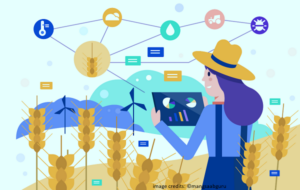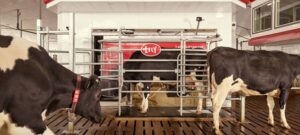Salome Loepfe
The human population is growing steadily and the available arable land per person decreases. Together with climatic changes this threatens the food supply. On the other side, new technologies are arising in the agricultural sector. Is it possible that these technologies can lead to sustainable intensification without losing quality?

1: Digitalization in agriculture (https://www.fao.org/e-agriculture/news/call-digital-agriculture-solutions-during-covid-19)
In the past the increasing food demand was covered by intensifying the production with applying fertilizers and pesticides to increase and protect the yield. Applying agrochemicals and fertilizers to fields imposes risks to the environment and humans. Additionally, the efficiency of them has decreased in the last decades (Oerke, 2006). This imposes the need for new strategies to increase productivity where digitalized technologies promise great possibilities (Trendov et al., 2019).
The technologies are all not a vision of a future which is utopic as many applications can already be found on the marked so that farmers could include them into their daily routine. Some examples listed here but there are many others (Trendov et al., 2019):
- Remote sensing technics can determine weather and soil conditions which can help with deciding on when and what crop best to plant to get a maximum yield. They can optimize irrigation rate to minimize overwatering and loss of nutrients due to erosion which.
- Databases provide data on different diseases for animals and can help preventing regional outspread which could decrease the number of vaccinations needed.
- Robots can support farmer b taking some work over such as weed control and thereby eliminating the use of pesticides. These robots are all decreasing the need of human time for timeconsuming handwork.
- Complete farming systems that interconnec and optimize the performance of the implemented systems.
These technologies promise to increase the productivity and will help the farmers to adapt to fast changing conditions as we will face due to climate change. Including digital tools is more sustainable then using more agrochemicals and can increase the food security now and for future generations. Digital technologies can interconnect the farmers which has the advantage of sharing knowledge and information in real time which helps every single farmer. Additionally, the value chanes will become more transparent helping to identify issues alongside of it (Trendov et al., 2019).
As everything in live with something good there is always a negative side to it. Thereby the farmers do have a lot of advantages due to these technologies but have to face the effects of the downside of it too. These new systems need great effort to get used to them with possible long transition phases where they might experience a decrease in yield. This change can be cutting throat for a farmer which is dependent on its regular income. The gap between high-income farmers in urban areas and low-income farmers in rural areas will widen as not everyone will be able to afford the new technologies and farmers will eventually be forced to abandon their practices.
There will always be more than one best solution and the way of “thinking out of the box” a farmer needs to do daily get lost by relying completely on a digitalized system (Ingram & Maye, 2020). The whole job profile of a farmer will change from a profession where you spend most of the time outside to a mainly office job evaluating data and planning further steps (Klerkx et al., 2019). This will cause a shift in people who are working on a farm. The education will change from mainly inherited knowledge to a scientistic learning which will bring unknown changes to the system (Ingram & Maye, 2020). As robots can be implemented less workers on the farm will be needed creating loss of jobs on the marked. By completely relying on a digitalized system lets the food provisioning be vulnerable to cyberattacks which could have a big influence when data would be manipulated or the system completely shut down (Klerkx et al., 2019).
Personal experience with lely-the milk robot
Working on a dairy farm can be really exhausting as the first thing every morning is to get up before sunrise to milk the cows. As this consumes a lot of work a robot has been developed in the Netherlands to take over that part of the routine from a farmer. It is installed in the cowshed and is openly available for the cows throughout the whole day. This opens the possibility for them to go to be milked whenever they feel like it. In the robot the cows are being fed with concentrated feed adjusted to each individual need. During the milking process the robot collects data from each cow concerning different milk properties or information about the health status of the cows and suggesting possible treatment options (Lely, 2022). On the farm I worked, the cows were already adapted to the system and most cows fit perfectly into the ideal picture the scientists had in their heads. Some of them even waited in line to be milked or went more often as they can be milked. Getting a cow, the first time into the robot is a lot of work and was hard for me to watch and some of the cows seemed to be just too lazy to go milking and needed some reinforcement from the farmer. But they seemed to learn the process quite fast.

2: Milking robot from Lely showing the part where the cow is milked in a stable (https://www.lely.com/de/neuigkeiten/2018/05/14/pilotkunden-uber-ihren-lely-astronaut-a5/)
Overall, I think the idea of letting the cows decide when they want to be milked is giving the cows back some freedom but as Driessen & Heutinck (2015) mentioned in their work, cows might not actually desire to be milked and rather experience it as a relieve. From a farmer’s perspective the robot gives back a lot of freedom and saves the farmer time which he can invest in other things. On the other hand, the time a farmer spends with his animals decreases and with it the relationship and his knowledge about them diminishes which for me is a great loss as the gut feeling we humans have can not be learned by any robot.
When implementing digital systems into our food production system we can not forget about difficulties which could arise when implementing them. These could be that the farmer loses the close relationship has with its animals or that creative human solutions might no longer have space in this system. But by tackling them in andvance I think these technologies can lead the way to a more sustainable intensification in agriculture.
Sources
Driessen, C., & Heutinck, L. F. M. (2015). Cows desiring to be milked? Milking robots and the co-evolution of ethics and technology on Dutch dairy farms. Agriculture and Human Values, 32(1). https://doi.org/10.1007/s10460-014-9515-5
Ingram, J., & Maye, D. (2020). What Are the Implications of Digitalisation for Agricultural Knowledge? Frontiers in Sustainable Food Systems, 4. https://doi.org/10.3389/fsufs.2020.00066
Klerkx, L., Jakku, E., & Labarthe, P. (2019). A review of social science on digital agriculture, smart farming and agriculture 4.0: New contributions and a future research agenda. In NJAS – Wageningen Journal of Life Sciences (Vols. 90–91). https://doi.org/10.1016/j.njas.2019.100315
Lely. (2022). Lely Astronaut A5 Der Meilenstein in der Melktechnik. https://www.lely.com/de/losungen/melken/astronaut-a5/
Oerke, E. C. (2006). Crop losses to pests. In Journal of Agricultural Science (Vol. 144, Issue 1). https://doi.org/10.1017/S0021859605005708
Trendov, N. M., Varas, S., & Zeng, M. (2019). Digital technologies in agriculture and rural areas. Briefing Paper (FAO). Food and Agriculture Organization of the United Nations.